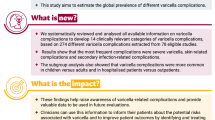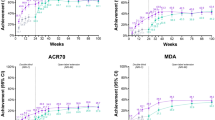Summary
Background & Aims Sorafenib-related adverse events have been reported as clinical surrogates for treatment response in hepatocellular carcinoma (HCC); however, no consensus has been reached regarding the definition of responders. We evaluated the predictive abilities of different definitions for sorafenib response based on treatment-emergent adverse events, aiming to identify the most discriminatory one as a clinical marker. Methods From January 2010 to December 2014, 435 consecutive HCC patients treated with sorafenib were enrolled. Considering the type, severity and timing of adverse events, twelve different categories of sorafenib response were defined. By comparing their discriminatory abilities for survival, an indicative criterion was defined, the prognostic value of which was evaluated by time-dependent multivariate analysis, validated in various subsets and confirmed by landmark analysis. Results Using concordance (C)-index analysis and time-dependent receiver operating characteristic curves, the development of a hand-foot-skin reaction ≥ grade 2 within 60 days of sorafenib initiation (2HFSR60) showed the highest discriminating value. Based on this criterion, 161 (37.0%) sorafenib responders achieved decreased risk of death by 47% (adjusted HR 0.53, 95%CI 0.43–0.67, P < 0.001) and likelihood of progression by 26% (adjusted HR 0.74, 95%CI 0.58–0.96, P = 0.020) compared with non-responders. Notably, 2HFSR60 remained an effective discriminator among most subgroups and had superior predictive ability to previous definitions, even according to the landmark analysis. Conclusions Our study demonstrated that 2HFSR60, with the best discriminatory ability compared to currently available definitions of sorafenib-related adverse events, could be the optimal clinical marker to identify sorafenib responders with decreased risk of death by half.





Similar content being viewed by others
Abbreviations
- HCC:
-
Hepatocellular carcinoma
- AASLD:
-
American Association for the Study of Liver Disease
- EASL:
-
European Association for the Study of Liver disease
- DAE:
-
Dermatologic adverse events
- HR:
-
hazard ratio
- TACE:
-
Transarterial chemoembolization
- ECOG:
-
Eastern Cooperative Oncology Group
- CT:
-
Computed tomography
- MRI:
-
Magnetic resonance imaging
- CTCAE:
-
Common Terminology Criteria for Adverse Events
- OS:
-
Overall survival
- TTP:
-
Time to progression
- mRECIST:
-
Modified Response Evaluation Criteria in Solid Tumors
- HFSR:
-
Hand-foot-skin reaction
- DAE:
-
Dermatological adverse events (including rash or/and HFSR)
- AE:
-
Any relevant adverse events (including HFSR, rash, diarrhea, alopecia and hypertension)
- HFSR30:
-
Developing HFSR in 30 days after the initiation of sorafenib
- 2HFSR30:
-
Developing HFSR ≥ grade 2 in 30 days
- DAE30:
-
developing DAE in 30 days
- 2DAE30:
-
Developing DAE ≥ grade 2 in 30 days
- AE30:
-
Developing any AE in 30 days
- 2AE30:
-
Developing any relevant AE ≥ grade 2 in 30 days
- HFSR60:
-
Developing HFSR in 60 days
- 2HFSR60:
-
Developing HFSR ≥ grade2 in 60 days
- DAE60:
-
Developing DAE in 60 days
- 2DAE60:
-
Developing DAE ≥ grade2 in 60 days
- AE60:
-
Developing any relevant AE in 60 days
- 2AE60:
-
Developing any relevant AE of ≥ grade 2 in 60 days
- IQR:
-
Interquartile range
- C-:
-
Concordance
- ROC:
-
Receiver operating characteristic
- PVTT:
-
Portal vein tumor thrombosis
- EHS:
-
Extrahepatic spread
- CI:
-
Confidence Interval
- AUC:
-
Area under receiver operating characteristic curve
- AFP:
-
α-fetoprotein
References
Heimbach JK, Kulik LM, Finn RS, Sirlin CB, Abecassis MM, Roberts LR, Zhu AX, Murad MH, Marrero JA (2018) AASLD guidelines for the treatment of hepatocellular carcinoma. Hepatology 67(1):358–380. https://doi.org/10.1002/hep.29086
Clinical Practice Guidelines EASL Management of hepatocellular carcinoma (2018). J Hepatol. https://doi.org/10.1016/j.jhep.2018.03.019
Forner A, Reig M, Bruix J (2018) Hepatocellular carcinoma. Lancet. https://doi.org/10.1016/S0140-6736(18)30010-2
Slamon DJ, Leyland-Jones B, Shak S, Fuchs H, Paton V, Bajamonde A, Fleming T, Eiermann W, Wolter J, Pegram M, Baselga J, Norton L (2001) Use of chemotherapy plus a monoclonal antibody against HER2 for metastatic breast cancer that overexpresses HER2. N Engl J Med 344(11):783–792. https://doi.org/10.1056/NEJM200103153441101
Tsao MS, Sakurada A, Cutz JC, Zhu CQ, Kamel-Reid S, Squire J, Lorimer I, Zhang T, Liu N, Daneshmand M, Marrano P, da Cunha Santos G, Lagarde A, Richardson F, Seymour L, Whitehead M, Ding K, Pater J, Shepherd FA (2005) Erlotinib in lung cancer - molecular and clinical predictors of outcome. N Engl J Med 353(2):133–144. https://doi.org/10.1056/NEJMoa050736
Dalerba P, Sahoo D, Paik S, Guo X, Yothers G, Song N, Wilcox-Fogel N, Forgo E, Rajendran PS, Miranda SP, Hisamori S, Hutchison J, Kalisky T, Qian D, Wolmark N, Fisher GA, van de Rijn M, Clarke MF (2016) CDX2 as a prognostic biomarker in stage II and stage III Colon Cancer. N Engl J Med 374(3):211–222. https://doi.org/10.1056/NEJMoa1506597
Dhanasekaran R, Venkatesh SK, Torbenson MS, Roberts LR (2016) Clinical implications of basic research in hepatocellular carcinoma. J Hepatol 64(3):736–745. https://doi.org/10.1016/j.jhep.2015.09.008
Chaiteerakij R, Addissie BD, Roberts LR (2015) Update on biomarkers of hepatocellular carcinoma. Clin Gastroenterol Hepatol 13(2):237–245. https://doi.org/10.1016/j.cgh.2013.10.038
Cho JY, Paik YH, Lim HY, Kim YG, Lim HK, Min YW, Gwak GY, Choi MS, Lee JH, Koh KC, Paik SW, Yoo BC (2013) Clinical parameters predictive of outcomes in sorafenib-treated patients with advanced hepatocellular carcinoma. Liver Int 33(6):950–957. https://doi.org/10.1111/liv.12168
Bettinger D, Schultheiss M, Knuppel E, Thimme R, Blum HE, Spangenberg HC (2012) Diarrhea predicts a positive response to sorafenib in patients with advanced hepatocellular carcinoma. Hepatology 56(2):789–790. https://doi.org/10.1002/hep.25637
Koschny R, Gotthardt D, Koehler C, Jaeger D, Stremmel W, Ganten TM (2013) Diarrhea is a positive outcome predictor for sorafenib treatment of advanced hepatocellular carcinoma. Oncology 84(1):6–13. https://doi.org/10.1159/000342425
Estfan B, Byrne M, Kim R (2013) Sorafenib in advanced hepatocellular carcinoma: hypertension as a potential surrogate marker for efficacy. Am J Clin Oncol 36(4):319–324. https://doi.org/10.1097/COC.0b013e3182468039
Akutsu N, Sasaki S, Takagi H, Motoya M, Shitani M, Igarashi M, Hirayama D, Wakasugi H, Yamamoto H, Kaneto H, Yonezawa K, Yawata A, Adachi T, Hamamoto Y, Shinomura Y (2015) Development of hypertension within 2 weeks of initiation of sorafenib for advanced hepatocellular carcinoma is a predictor of efficacy. Int J Clin Oncol 20(1):105–110. https://doi.org/10.1007/s10147-014-0691-5
Vincenzi B, Santini D, Russo A, Addeo R, Giuliani F, Montella L, Rizzo S, Venditti O, Frezza AM, Caraglia M, Colucci G, Del Prete S, Tonini G (2010) Early skin toxicity as a predictive factor for tumor control in hepatocellular carcinoma patients treated with sorafenib. Oncologist 15(1):85–92. https://doi.org/10.1634/theoncologist.2009-0143
Otsuka T, Eguchi Y, Kawazoe S, Yanagita K, Ario K, Kitahara K, Kawasoe H, Kato H, Mizuta T, Saga Liver Cancer Study G (2012) Skin toxicities and survival in advanced hepatocellular carcinoma patients treated with sorafenib. Hepatol Res 42(9):879–886. https://doi.org/10.1111/j.1872-034X.2012.00991.x
Shin SY, Lee YJ (2013) Correlation of skin toxicity and hypertension with clinical benefit in advanced hepatocellular carcinoma patients treated with sorafenib. Int J Clin Pharmacol Ther 51(11):837–846. https://doi.org/10.5414/CP201907
Reig M, Torres F, Rodriguez-Lope C, Forner A, LL N, Rimola J, Darnell A, Rios J, Ayuso C, Bruix J (2014) Early dermatologic adverse events predict better outcome in HCC patients treated with sorafenib. J Hepatol 61(2):318–324. https://doi.org/10.1016/j.jhep.2014.03.030
Zhao Y, Li H, Bai W, Liu J, Lv W, Sahu S, Guan S, Qin X, Wang W, Ren W, Mu W, Guo W, Gu S, Ma Y, Yin Z, Guo W, Wang W, Wang Y, Duran R, Fan D, Zhang Z, Han G (2016) Early sorafenib-related adverse events predict therapy response of TACE plus sorafenib: a multicenter clinical study of 606 HCC patients. Int J Cancer 139(4):928–937. https://doi.org/10.1002/ijc.30124
Zhong BY, Ni CF, Chen L, Zhu HD, Teng GJ (2017) Early Sorafenib-related biomarkers for combination treatment with Transarterial chemoembolization and Sorafenib in patients with hepatocellular carcinoma. Radiology 161975. https://doi.org/10.1148/radiol.2017161975
Song T, Zhang W, Wu Q, Kong D, Ma W (2011) A single center experience of sorafenib in advanced hepatocellular carcinoma patients: evaluation of prognostic factors. Eur J Gastroenterol Hepatol 23(12):1233–1238. https://doi.org/10.1097/MEG.0b013e32834bd2d0
Di Costanzo GG, de Stefano G, Tortora R, Farella N, Addario L, Lampasi F, Lanza AG, Cordone G, Imparato M, Caporaso N (2015) Sorafenib off-target effects predict outcomes in patients treated for hepatocellular carcinoma. Future Oncol 11(6):943–951. https://doi.org/10.2217/fon.14.291
Ponziani FR, Bhoori S, Germini A, Bongini M, Flores M, Sposito C, Facciorusso A, Gasbarrini A, Mazzaferro V (2016) Inducing tolerability of adverse events increases sorafenib exposure and optimizes patient's outcome in advanced hepatocellular carcinoma. Liver Int 36(7):1033–1042. https://doi.org/10.1111/liv.13052
Howell J, Pinato DJ, Ramaswami R, Bettinger D, Arizumi T, Ferrari C, Yen C, Gibbin A, Burlone ME, Guaschino G, Sellers L, Black J, Pirisi M, Kudo M, Thimme R, Park JW, Sharma R (2017) On-target sorafenib toxicity predicts improved survival in hepatocellular carcinoma: a multi-Centre, prospective study. Aliment Pharmacol Ther 45(8):1146–1155. https://doi.org/10.1111/apt.13977
Ogawa C, Morita M, Omura A, Noda T, Kubo A, Matsunaka T, Tamaki H, Shibatoge M, Tsutsui A, Senoh T, Nagano T, Takaguchi K, Tani J, Morishita A, Yoneyama H, Masaki T, Moriya A, Ando M, Deguchi A, Kokudo Y, Minami Y, Ueshima K, Sakurai T, Nishida N, Kudo M (2017) Hand-foot syndrome and post-progression treatment are the good predictors of better survival in advanced hepatocellular carcinoma treated with Sorafenib: a multicenter study. Oncology 93(Suppl 1):113–119. https://doi.org/10.1159/000481241
Rimola J, Diaz-Gonzalez A, Darnell A, Varela M, Pons F, Hernandez-Guerra M, Delgado M, Castroagudin J, Matilla A, Sangro B, Rodriguez de Lope C, Sala M, Gonzalez C, Huertas C, Minguez B, Ayuso C, Bruix J, Reig M (2017) Complete response under sorafenib in patients with hepatocellular carcinoma: relationship with dermatologic adverse events. Hepatology. https://doi.org/10.1002/hep.29515
Granito A, Marinelli S, Negrini G, Menetti S, Benevento F, Bolondi L (2016) Prognostic significance of adverse events in patients with hepatocellular carcinoma treated with sorafenib. Therap Adv Gastroenterol 9(2):240–249. https://doi.org/10.1177/1756283X15618129
Wang W, Bai W, Wang E, Zhao Y, Liu L, Yang M, Cai H, Xia D, Zhang L, Niu J, Yin Z, Zhang Z, Fan D, Xia J, Han G (2017) mRECIST response combined with sorafenib-related adverse events is superior to either criterion alone in predicting survival in HCC patients treated with TACE plus sorafenib. Int J Cancer 140(2):390–399. https://doi.org/10.1002/ijc.30451
Llovet JM, Ricci S, Mazzaferro V, Hilgard P, Gane E, Blanc JF, de Oliveira AC, Santoro A, Raoul JL, Forner A, Schwartz M, Porta C, Zeuzem S, Bolondi L, Greten TF, Galle PR, Seitz JF, Borbath I, Haussinger D, Giannaris T, Shan M, Moscovici M, Voliotis D, Bruix J, Group SIS (2008) Sorafenib in advanced hepatocellular carcinoma. N Engl J Med 359(4):378–390. https://doi.org/10.1056/NEJMoa0708857
Roberts LR (2008) Sorafenib in liver cancer--just the beginning. N Engl J Med 359(4):420–422. https://doi.org/10.1056/NEJMe0802241
Bruix J, Qin S, Merle P, Granito A, Huang YH, Bodoky G, Pracht M, Yokosuka O, Rosmorduc O, Breder V, Gerolami R, Masi G, Ross PJ, Song T, Bronowicki JP, Ollivier-Hourmand I, Kudo M, Cheng AL, Llovet JM, Finn RS, LeBerre MA, Baumhauer A, Meinhardt G, Han G, Investigators R (2017) Regorafenib for patients with hepatocellular carcinoma who progressed on sorafenib treatment (RESORCE): a randomised, double-blind, placebo-controlled, phase 3 trial. Lancet 389(10064):56–66. https://doi.org/10.1016/S0140-6736(16)32453-9
Funding
National Natural Science Foundation of China (81172145 and 81420108020).
Author information
Authors and Affiliations
Corresponding author
Ethics declarations
Conflict of interest
None.
Ethical approval
All procedures performed in studies involving human participants were in accordance with the ethical standards of the institutional and/or national research committee and with the 1964 Helsinki declaration and its later amendments or comparable ethical standards.
Informed consent
Informed consent was obtained from all individual participants included in the study.
Rights and permissions
About this article
Cite this article
Wang, E., Xia, D., Bai, W. et al. Hand-foot-skin reaction of grade ≥ 2 within sixty days as the optimal clinical marker best help predict survival in sorafenib therapy for HCC. Invest New Drugs 37, 401–414 (2019). https://doi.org/10.1007/s10637-018-0640-7
Received:
Accepted:
Published:
Issue Date:
DOI: https://doi.org/10.1007/s10637-018-0640-7




